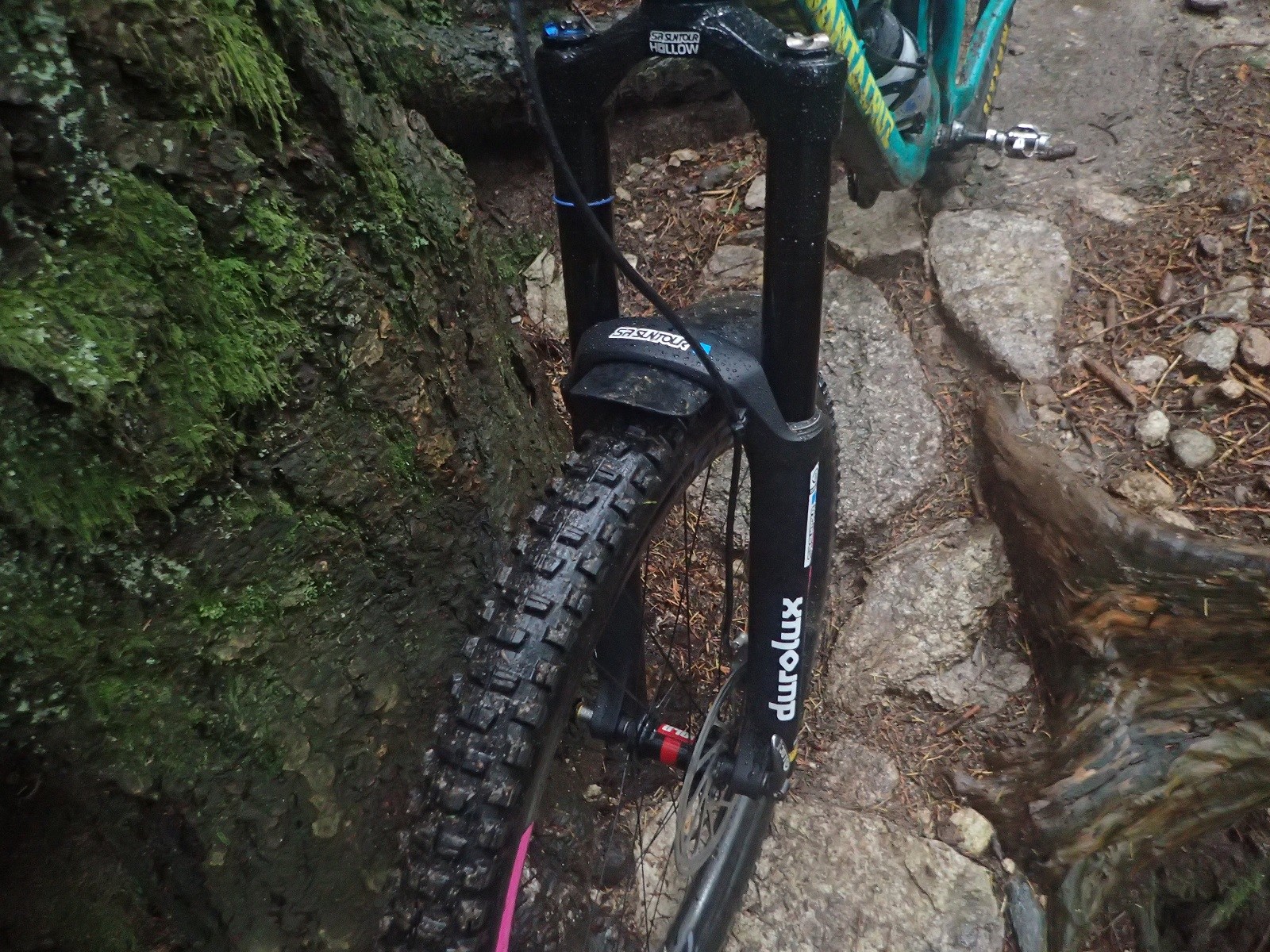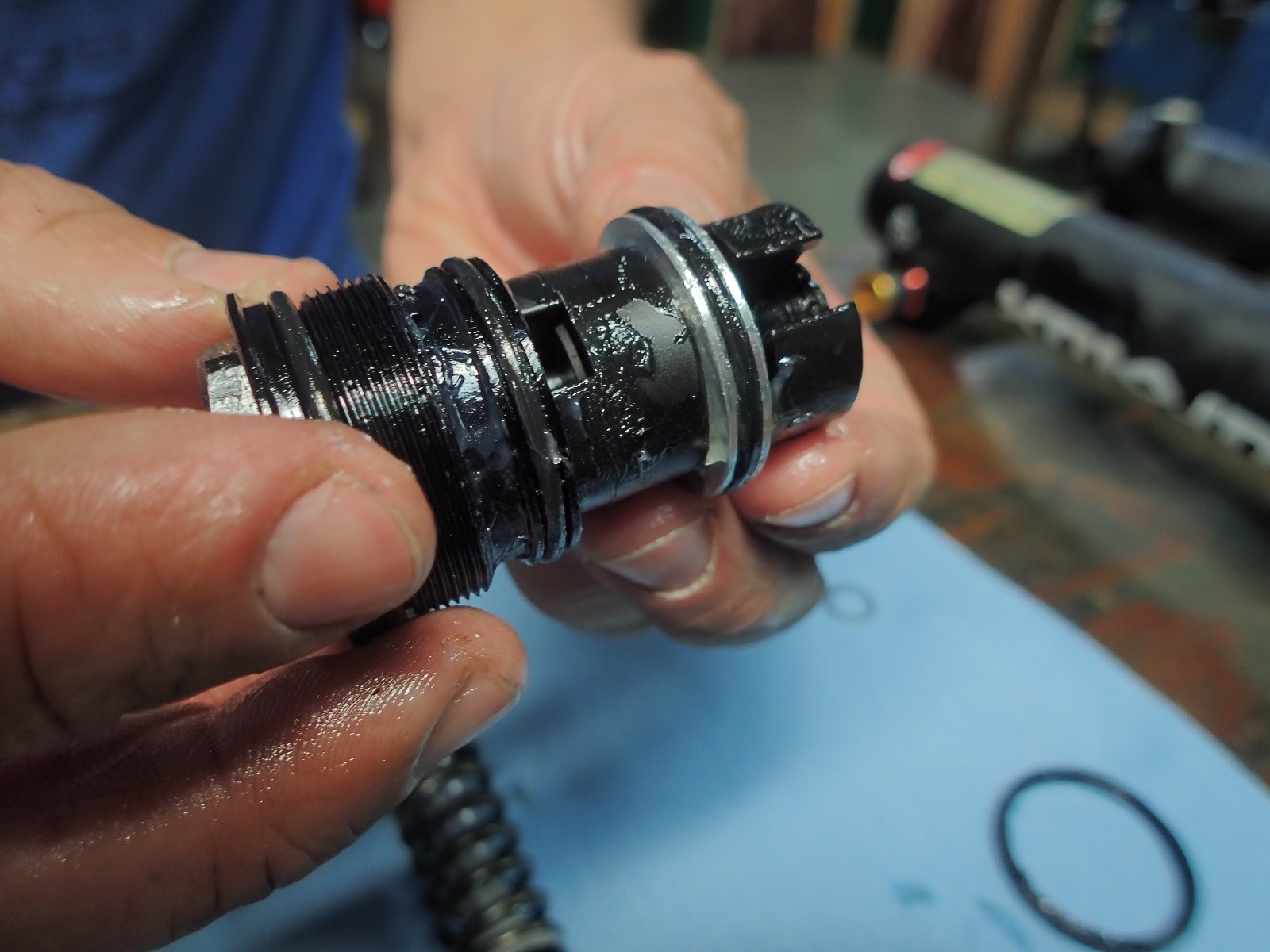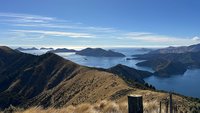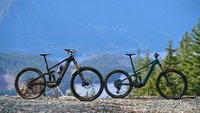
Review
SRSuntour Durolux R2C2 (Updated)
UPDATE
While the performance of the Suntour Durolux R2C2 was excellent the value vs. damper noise proposition is definitely something that would deter some riders from investing in the fork. Suntour sent me out their latest version of the Durolux damper and the fork saw another couple months of use.
The damper swap was a one beer job and easily accomplished without fully dissembling the fork. The new version had a broader range of usable rebound adjustment for my weight, was smoother right out of the box and in addition to the performance improvements it was significantly quieter - on par for noise with other non-bladder dampers like BOS or Ohlins.
This makes the fork much easier to recommend. Push 7-10ml of fork oil in each side of the lowers and spend the difference on a mean brake system or some top end tires. Either option will make a bigger performance difference than the spread between the Durolux and more a boutique suspension fork.
Dropping In
Lets say I’m standing at the top of an aggressive mountain bike trail. The type where I’d appreciate a 170mm or 180mm fork. To my left is a rider with a RockShox Lyrik RCT3. To my right is a rider with a Fox 36 Float RC2. Heck, every high end “enduro” fork is represented. I’m straddling a Santa Cruz Nomad with a SRSuntour Durolux R2C2. Who goes first? Who goes last? What does the Durolux have to do with it?
The SRSuntour Durolux R2C2 may be $200-$300 cheaper than similar forks but it isn’t a built in excuse. If I can’t keep up to my friends on their more boutique Lyriks and Floats its me, not the fork.
In this review, I’m going to say some things about the $800 (USD) SRSuntour Durolux that are very positive. I’m going to give some constructive feedback for some easy changes I’d like to see. I’m going to bemoan some issues. But, in conclusion I want to say that compared to all of the more expensive forks in this travel category the Durolux offers up no excuses whatsoever.
Whether or not I can justify the extra $200-$300 (USD) for the superior fit-and-finish of competing products, when it comes time to drop-in the Durolux isn’t making one iota of difference to my place in line.
SRSuntour Durolux R2C2
This is the same fork that was featured in a teardown with Jeff of Bikeroom in July. It has a basic, straight forward air system with a large coil negative spring and a very robust chassis. The R2C2 damper has a wide range of usable adjustment. The street price of around $800 (USD) is very reasonable for this category of fork.
The out of the box feel is significantly better than past SRSuntour forks and, as I noted in the teardown, the new damper is significantly quieter. In a blind test pushing on the handlebar the SRSuntour Durolux could easily be mistaken for any high-performance fork in this category.
It’s not light. I don’t think its pretty – mainly down to the graphics. The price to performance ratio is excellent for the 170mm/180mm travel category. It’s one of the simplest forks on the market.
I do think that SRSuntour should revisit its QSP (Quick Service Product) dogma. The basic idea behind the QSP concept is great – super easy end user serviceability. But, making a fork service as simple as possible – whether a cartridge service or lower service – should not come at the expense of performance. This fork was shipped with grease in the lowers instead of oil – to make service super quick and easy – and as smooth as the Durolux felt out of the box it absolutely came alive after a service.
The big change was 10cc of 0W-30 fork oil in each side of the lowers, which really isn’t adding a great deal of complexity come service time.
The Air System
Attach pump. Inflate. Check sag. Ride. The basic setup on the SRSuntour Durolux is straight forward. I experimented between 20% and 25% sag and settled in around the mid-point. The initial feel of the Durolux is very similar to RockShox’s premier longer travel forks, the Pike and Lyrik, and I also prefer to run those forks at around 23% sag.
A refresher on the Durolux air system from my teardown with Jeff. Swapping the black spacers onto either side of the silver air seal changes the fork volume substantially. Too substantially. I’d love to see four spacers instead of two.
Like the Pike, the Durolux would benefit from volume spacers in half sizes (something RockShox has really dialed in with the Lyrik). In the case of the Durolux, one spacer did not yield enough progression but two prevented a rider of my weight and ability from using the last 20mm-30mm of travel with any regularity.
After experimenting with running one spacer and some additional Float fluid in the air system, I decided to go with the best possible feel while sacrificing full travel. On a positive note, the 180mm fork truly felt bottomless. If this was my personal fork I would modify volume spacers to further experiment with the perfect sweet spot.
Adjusting the travel on the Durolux from 180mm, to 170mm, to 160mm, or even to 100mm is quick and easy. I rode the Durolux on the front of the Nomad at both 180mm and 170mm.
The Damper
As complicated as it sounds, the four adjustments of the SRSuntour Durolux’s R2C2 damper were quick and easy to set up.
From closed here are my base settings:
LSC (low speed compression) -7 clicks
LSR (low speed rebound) -22 clicks
HSC (high speed compression) -3 clicks
HSR (high speed rebound) -2 clicks
That is for a 185lb rider on the Nomad with the fork at 170mm travel and 23% sag.
It seems to me that in an age of tunable air volume it is superfluous to offer adjustable HSC and HSR on most forks. It can be daunting to a potential purchaser and compared to a factory setting, and without base settings, the high-speed adjustments often do more harm than good to performance. I would personally prefer to see SRSuntour following RockShox’s lead here by offering only adjustable LSC and LSR combined with the air volume spacers and pressure to tune the fork.
High and Low speed compression adjustments up top and mirrored rebound adjusters on the bottom. Other than adjusting the low speed rebound when temperatures dropped, I found the Durolux to be an enjoyably ‘set-and-forget’ product.
Previous SRSuntour fork dampers never felt great on the shop floor but they were always very capable on the trail. And they performed best when ridden hard. With the new damper, adjustments aside, the fork is very smooth and from the first push it feels like a competitive product.
With the fork all setup, I headed out for my first ride. Deep in the ‘okay, what am I feeling?’ zone on a trail I know well, I lost focus and stuck the front wheel into a gaping wheel sucker, throwing my weight forward hard. And then… *Loud FARTING Noise*. “What was that?”
Huh?
With headphones on the Durolux’s damping feels seamless and supportive. However, in certain G-out situations I regularly experienced the aforementioned farting noise. The sound is more obvious and occurs with greater regularity when you firm up the compression damping (HSC & LSC) so my conclusion is the noise is made by oil being forced through the ports.
The dampers in older SRSuntour RC2 forks could also be quite loud if you ran the ported rebound circuit quite slow so this wasn’t completely a surprise. It isn’t an issue at all with higher end dampers from the likes of Fox, RockShox, and X-Fusion so hopefully it is something Suntour will fix with future iterations of the fork.
As complicated as R2C2 sounds, it’s actually a pretty simple assembly. The ported compression circuit (gray plastic circuit in upper right hand corner) is the likely culprit for the farting noise the Durolux makes in certain circumstances.
As with the Auron and Durolux RC2 I’ve ridden in the past, running the ported circuits more open reduces the frequency of the noise but it never goes away. It seems to have absolutely zero effect on performance but I know folks who complain about the sound of their Cane Creek CCDB Coil shock ‘breathing’ so it’s a fair warning.
Cosmetically Speaking
Noise aside and adjusters aside, the performance of the SRSuntour Durolux is very good. Cosmetically it has some nice features as well. The beefy arch is confidence inspiring, the lowers are clean looking, and the bolt-on fender is a nice detail. I also think the black stanchions are a nice appearance upgrade from previous generations.
SRSuntour’s bolt-on fender is very clean and is quick to remove and install although I just left it on for the whole test period. Its made of thick, firm, plastic and has proven durable thus far.
I have no issue with the function of Suntour’s Q-LOC2 axle system but I would prefer to see a bolt on version simply for the cleaner and more ‘DH’ look of the competition. I also think SRSuntour could go a long way in improving the sex appeal of the Durolux with fresh graphics.
What is $300 worth?
Ignoring clearouts and bro-deals, the street price on an SRSuntour Durolux is going to net $200-$300 (USD) in savings compared to other performance 170mm and 180mm forks. Yes, the Durolux gives up varying ground on fit, finish, and feel. And no, $800 is still not cheap.
Trying to maximize performance on a budget there are places – especially the rear hub, tires, dropper post, and brakes – where I would argue you could obtain a lot more performance value out of a $300 upgrade than by swapping out the Durolux. If your rebuttal references a long-term investment in the much more refined, sophisticated, and proven Fox RC2 damper then touché (or the well-performing and incredibly low maintenance Pike – Ed.). Let’s debate it over a couple of beers.
SRSuntour’s Durolux R2C2 is an easy fork to recommend on a budget. $300 can go a long way in upgrading the brakes, tires, rear hub, dropper post, etc. on a carefully selected build.
Buy In? Buy It?
I don’t think that fresh graphics, a bolt-on axle or adding sizes to the volume token selection would increase the price dramatically and I would love to see those changes. For me the occasional damper noise wouldn’t completely steer me away from performance and value the Durolux brings – but I would love the fork to be quieter. I appreciate the ease of serviceability, even if I do think the fork should ship with oil in the lowers instead of just grease.
I buy into what SRSuntour is offering: competitive performance at a lower price. It doesn’t matter what ride order philosophy is being used, the Durolux is not changing my position in line compared to a more boutique suspension product.
Without the aforementioned changes, I can’t honestly say whether I would buy a Durolux or come up with the extra $300 for a more sophisticated damper and better looking product – I don’t think the Durolux gives up anything in terms of the robust chassis – but I would definitely consider it. A few cosmetic changes, more micro-adjustment in the air system, and a more simple-and-silent damper: I’m sold!
SRSuntour Durolux anybody?















Comments
Esteban
8 years, 5 months ago
And, in another but related subject: why on earth would anyone want to LESSEN the travel of their forks? Wouldn't buying a shorter travel fork be cheaper in the first place?
Reply
DrewM
8 years, 5 months ago
I know a lot of riders my size or heavier - who aren't racing XC - who prefer to take a bit of a weight penalty and run a more robust chassis. I have happily run 140mm Fox 34 Float forks or my 140mm Auron lowered to 100mm or 120mm on Shore-XC bikes since ~2012. It is a marked improvement compared to a Fox 32 or a SID for example.
Specifically in the case of Suntour - and the reason I mention 100mm - a number of their sponsored dirt jumpers were running the previous (26″) generation Durolux lowered to 100mm travel for that application.
Just because the majority of potential customers would only run this fork as a 180mm, 170mm, or 160mm fork doesn't mean it doesn't bear mentioning that the skies the limit in terms of travel adjustment and I think it's reasonable to use my discretion to include such details.
Reply
Esteban
8 years, 5 months ago
Oh! I see, that makes sense then, thanks!
Reply
Esteban
8 years, 5 months ago
But… is this because forks are somewhat weak, that you feel the need to go one up and bring it down "just to be safe"?
Reply
Esteban
8 years, 5 months ago
This review is useless and it doesn't serve any purpose, it doesn't apply of represent any true characteristic of the fork because they opened it and ran it outside factory design; it is not just and fair to the brand.
"Too substantially. I’d love to see four spacers instead of two"
"one spacer did not yield enough progression but two prevented a rider of my weight…"
"If this was my personal fork I would modify volume spacers to further experiment with the perfect sweet spot." Why? You do this with all your forks? Changing them so outside of factory design that you really can't say you're running this or that brand/model?
"Adjusting the travel on the Durolux from 180mm, to 170mm, to 160mm, or even to 100mm is quick and easy." No, it's not! You have to open the fork and get some hard to come by parts!
"I would personally prefer to see SRSuntour following RockShox’s lead here by offering only adjustable LSC and LSR". What? You go out of your way to change the innards of the thing -thus effectively incrasing the fork's options-, and then you claim for less options?
(On a side note, we humans really like fewer options. Fewer options makes us happier).
"adjusting the low speed rebound when temperatures dropped". Surely this is preposterous. One would think that Operational (by just riding) Temperature would be exactly the same no matter which but the most extreme temperatures.
"The ported compression circuit (gray plastic circuit in upper right hand corner) is the likely culprit for the farting noise the Durolux makes in certain circumstances."
"running the ported circuits more open reduces the frequency of the noise".
" I do think the fork should ship with oil in the lowers instead of just grease".
No. Running OIL through it, when it's supposed to work on grease, is the culprit. You're the culprit!
-Finds flaw. Culprit is the after-market modification. > Recommends the after-market modification as Factory Standard.
WHAT?
"the Durolux gives up varying ground on fit, finish, and FEEL". How can you say that? You never used it as intended!
Terrible, terrible "review". You seriously can't expect anyone but professional riders maybe, to possibly relate to this "review", and professional riders won't use this fork, so again: irrelevant "review"!
Reply
DrewM
8 years, 5 months ago
Wow. Okay.
1) It's a sealed damper cartridge not an open bath. Adding oil to the lowers doesn't have any affect on the cartridge. In this case I'm advocating using a bit of oil (~10cc per side) to reduce friction and maintain better performance between services. It is how I run my own Suntour fork.
2) I haven't ridden a fork that doesn't need the rebound damping decreased (sped up) when temperatures drop. It's generally 1-2 clicks. This is the general experience of everyone I ride with, and the temperature range in North Vancouver is fairly mild.
3) Adjusting the travel is quick and easy and comparable to any brands forks that are internally adjustable. It does not require more than a very basic understanding of fork service. Most shops I know will do it for free if you are purchasing a fork, so if it is outside of your technical ability it is a cheap & easy service to have done. Suntour ships the fork with a couple of plastic travel spacers (comes with the parts to run it at 180, 170, or 160mm) and they are happy to sell you more. I have an Auron and it was absolutely no issue to get the parts - through an SRSuntour service center - to lower it from 140mm to 100mm.
4) Actually, I do modify tokens for Pike forks. I prefer to run 2.5 tokens in a 150mm or 160mm Pike and it makes an obvious difference from 2 or 3. I think one of the huge improvements RockShox made with the Lyrik is that the difference in adding/removing a token is much less abrupt than the Pike.
4a) I'm curious why its a big deal to suggest that the Durolux would be better if SRSuntour used 4 smaller tokens instead of 2 larger ones? It would add nothing to the cost of the fork. I think the majority of riders have grown accustomed to riding forks with micro-adjustable air volume (Fox, RockShox) and I'm suggesting smaller variations would be beneficial.
4b) I think air volume, low speed compression, and low speed rebound offer the most obvious perceivable ride differences and so, for all but the most advanced tinkerers, those are the most beneficial adjustments.
5) The fork was used by both Pete and myself before the teardown article. The teardown was performed with someone - Jeff - who has experience working on Suntour forks. The teardown certainly only affected fork performance in positive ways.
Best wishes,
Andrew
Reply
Esteban
8 years, 5 months ago
Hey, didn't meant it as rude, sorry if it came across like that -English is not my native language-, so there's no need to use sarcasm (thanks for editing that out!); me stating this review is useless, it not in any way an insult to you -it's an opinion on something you wrote, or even on your opinion-, that would be a logical fallacy from your part (believing that).
1.You said yourself that the noise was caused by you adding oil. I'd say that's an effect.
2. Oh, I didn't know that, I thought common temperature changes would have no effect on such a small and contained system!
3. This is more to my point: do you really think most buyers of this fork would know, or even went to the trouble to have the store do it, how to open a fork?
Also, I didn't know they came with parts for lessen the travel, so I guess in USA this is really common?
I really can't understand why someone would like less travel on a bought fork.
4. Yes, you're a big fan and know how to… -what is effectively a mod- mod your fork. Do you think most people are?
4a. There you're right, absurd point from my part.
5. The intention remains, or the effect: of not truthfuly reviewing a product, and of not considering that most of your public expects a plain (not modded) review because most likely, they won't do the mod?
I think it's a big deal because you're not giving a product's honest review, but to its after-market version, so it doesn't really tells us how the fork will perform, what can we expect, when we put it on our bikes. Maybe make it two-part, factory and modded? That'd be great!
Best wishes!
Reply
DrewM
8 years, 5 months ago
Could you please quote for me where it says that "the noise was caused by [me] adding oil" to the lowers of the fork?
That isn't the case so I would like to fix it if something is unclear. I see where it says adding damping (oil being forced through smaller ports in the closed system) causes the noise to increase.
Other than adding the aforementioned 10cc of oil to each side of the lowers (easily accomplished by the fork owner or shop and recommended to any Suntour owner in both the teardown and this article) the teardown article is showing a full factory rebuild. There is nothing "modded" about the fork.
Furthermore, I'm on record as advocating a basic lower service on any/all new forks to make sure seals and bushings are properly lubed. Even if a fork is built perfectly from the date it is manufactured to the date it is ridden lube can pool in the lowers resulting in sub-par performance from dry seals/bushings.
I'm sorry that the review is useless to you and that's totally fair. I do not appreciate the tone of the original post. Hence my unjustified/unprofessional sarcastic sign-off which I have removed.
…
As a fair warning, you will likely want to avoid any/all of my future works. I bleed ALL brakes before I ride them. All forks I review are subject to at minimum a basic lower service. All wheels will be conditioned for my local climate (for example: bearings greased / pawls & springs lubed). This is how I ride my own equipment, it is what I recommend to anyone who wants to maximize the performance of what they ride, and in order to fairly compare products within my own experiences I feel it is necessary.
I do not agree that it is "not honest" to review product in this way - and in face I think the opposite is true. I referenced the teardown a number of times in this article - and in all similar articles - which I feel is more than ample disclosure.
As an aside. Mountain biking is expensive. Really expensive. And the best way to achieve the maximum value out of expensive components - like "budget" $800 forks - is service. A good service, as was demonstrated in the teardown, improves performance, improves performance longevity, and significantly increases the life of a product. Value.
Reply
jerome
8 years, 5 months ago
Hi all,
Just one tips, it's not true that you can add oil in the lower legs without problem because this fork have a sealed damper cartridge.
When you do that, you have to take care to put a very small quantity of oil, if you put too much oil, at the end of travel, there is not enough room in the lower legs for oil and cartridge. So with the pressure going up, lubrification oil can go inside the cartridge, you will have less travel, it will modificate the compression curve and polluate the hydraulic oil.
You can add oil but in small quantity.
cheers,
Jerome.
Reply
DrewM
8 years, 5 months ago
Hello Jerome,
As was noted in the review and teardown ( ) 10cc/ml of oil was added to each side of the lowers. This is a small amount and there is ample room in the fork lowers to accommodate that amount of oil at full travel without forcing excess into the damper.
Reply
jerome
8 years, 5 months ago
Drew,
10 cc is perfect!
I just gave some precision for everyone to understand what could happened if you do not follow recommandation.
Jerome.
Reply
Pete Roggeman
8 years, 5 months ago
Hi Esteban,
While we definitely appreciate your feedback, it might be important to let you know that, in our opinion, this represents not only a very thorough review, but a very honest one as well. You won't find many fork reviews out there that are as detailed or performed by someone with Andrew's level of knowledge and experience. He has worked in several high quality bike shops as well as for a suspension tuning and maintenance facility, and brings a lot to the table in terms of getting the most performance and durability out of a fork or shock.
I can appreciate english isn't your native language, but you do write very well. Do be aware that using words like 'useless' to describe a review that involved a LOT of work is going to prompt a defensive response. I'm actually impressed that Drew responded to you at all. At the same time, letting us know why the review helped or did not help you is good information for us. In future, though, as Drew mentioned, be aware that we generally write longer, more detailed reviews than many other publications. There are a lot of one or two paragraph 'reviews' out there, and their conclusions may be valuable, but we don't think that gives enough information to the reader. Now you know a little more about us. One more thing, we're based in Canada 😉
As for our readers, they vary in terms of level of knowledge or desire to 'mod' their forks, however the advent of air-sprung suspension has prompted most manufacturers to make it easy to add volume spacers and play around with their suspension's performance. In our experience, it is now very common for riders that you could classify as 'moderate' enthusiasts to remove their own lowers and perform a basic service, or play around with air tokens. Therefore while it may not be common in your neck of the woods, a large portion of our regular readership either work regularly on their own bikes, or want to know more about what is going on inside of them. A fork review would therefore be incomplete if it didn't include information about making adjustments to travel or volume - Andrew just took it a few steps further as a bonus.
I hope you keep coming back to read our articles. We take a lot of pride in our content and work hard to get it right. We do welcome the feedback, just be aware that strong language usually elicits a strong response.
Have a great weekend,
Pete
Reply
Esteban
8 years, 5 months ago
Yes, it obvious the amount of work you put in these reviews; I meant "useless" as in useless for someone that won't "mod" the fork, but I'm beginning to understand this is common (in USA and Canada), so the review is more on point that what I thought!
Sorry, here in my backwater country we are blessed if we have forks!
I'm subscribed to your blog via my rss reader because I enjoy it (you, pinkbike, bikerumor, and two or three in spanish), and as I've said, I intended my reply as a statement of opinion, not a personal attack. Will try to check out more appropriate synonyms next time!
The "dishonest" part, was meant as in "cheating", as in "this fork works great if and only if you only keep the side decals and change everything inside": it maybe misinforms us to a point, because as I've said, I think most people won't do that to their forks (but you keep mentioning it's common). Not as in "the author is a dishonest person".
Also, I don't own an air fork, so I'm not quite familiar with it's inner workings, and I was under the impression that you set the sag, and the other 3 or 4 knobs and that was about it… Apparently not!
Thanks for your replies!
Reply
Esteban
8 years, 5 months ago
"so my conclusion is the noise is made by oil being forced through the ports" there, and because of the things mentioned after, I got the impression that it was the oil you added that caused the noise.
I'm beginning to understand that what you've done is common and not considered a "mod", I was under a wrong premise, so your review is a very different read knowing that!
I meant "useless" -considering what I've said before- as in "it doesn't work for anyone that doesn't do all this mods"… That I understand now as common "setting up".
Of course not, I enjoy reading all that is written here, again, sorry if I came across as rude!
About your last paragraph… One would think that anything at and over $800 would not need prior service to perform at 100%. If there is such a need, then manufacturers are… well, not giving us what they claim, maybe? I completely understand service after using something for a while, I myself try to keep my bike clean and lubed after some dirt has accumulated.
For example, when I buy a new chain, it goes a long time without it needing lubricating, but once I do that, the time between needing lubricating decreases very noticeably (by the end of the life of the chain, I'm cleaning it every week or so!), so factory settings (factory grease?) is better and best applied than my own attempts.
Thanks!
Reply
Pete Roggeman
8 years, 5 months ago
Esteban,
It's quite all right, and I appreciate your response - and you also responded graciously to Andrew. No one took it personally, just sticking up for the work!
I do understand your position on a few of these points, but maybe you also understand now where Andrew is coming from and why the extra work is a good step to making your $800 or $1100 fork work at its best. Yep, air forks can be easy and good. But with a little work, many of them can be great - and that's what we're helping people to understand. Here's another article you may be interested in, that we have had a ton of positive feedback about, which goes into some detail about tuning air springs and how easy it is to do with some of SRAM's products:
Thanks for sticking with us.
Reply
Esteban
8 years, 5 months ago
Thanks, will read it!
Reply
grambo
8 years, 5 months ago
How many clicks of adjustment does the damper have? For a 185lbs rider it seems odd you would have to run the HSC that hard (3 clicks from closed -- assuming it has 20-24ish clicks of adjustment).
LSC (low speed compression) -7 clicks
LSR (low speed rebound) -22 clicks
HSC (high speed compression) -3 clicks
HSR (high speed rebound) -2 clicks
Reply
DrewM
8 years, 5 months ago
HSC has five positions. Apologies as I should have mentioned that. Likewise the HSR is a limited position affair.
Reply
grambo
8 years, 5 months ago
Ahh that makes a lot more sense, so you are kind of mid-range tending toward more closed which makes sense for weight. Cheers Drew.
Reply
DrewM
8 years, 5 months ago
No problem at all! Thank you for keeping me honest 🙂
Reply
ChrisB
8 years, 5 months ago
The review mentions the xfusion, but doesn't compare it's performance to it.. Given that the suntour costs only about 100$ less, I think it would be fair to compare them!
Reply
DrewM
8 years, 5 months ago
Hi Chris,
I've ridden X-Fusion's shorter travel trail forks and I'm riding a 140mm Trace with the Roughcut HLR damper right now and I love it.
I haven't got enough time on a Metric to make a real comparison (whereas I have lots of hours on Lyrik, Pike, and 36) and I have not ridden the new Metric with the Roughcut damper hence the lack of direct comparison in the review.
I will say for my budget and based on my experience X-Fusion's forks are an easy buy. They're working on a 29'er version of the Metric Roughcut HLR and when that's released I will be in the market for one for my personal bike.
Thanks for reading!
Reply
kaw kaw
7 years, 4 months ago
man i'm all in for cheaper but similar performance forks. infact i live close to taiwan and have been experimenting a lot with lesser known brands for frame/forks (imo the most expensive parts) to reduce costs.
I've been riding since 1984 man and i can tell u, dont buy into the sh*t the big brands will talk abt character/essence of a component. yes ofcourse they do their research/testing hardwork to produce their components. but at the same time someone in another part of the world works equally hard/now has adequate testing facilities but lacks english speaking skills hence unable to market/demand higher prices for their products. i've spent my share of dough on top brands and its not worth it.
search for the smaller but hardworking brands and try them, you wudnt be disappointed.
the review is excellent :) there is a 25% discount on it currently too.
another request to Andrew: DNM is a good taiwanese brand as well with forks/shocks at incredible value pricing, if you get your hands on them pls do review.
Reply
Please log in to leave a comment.